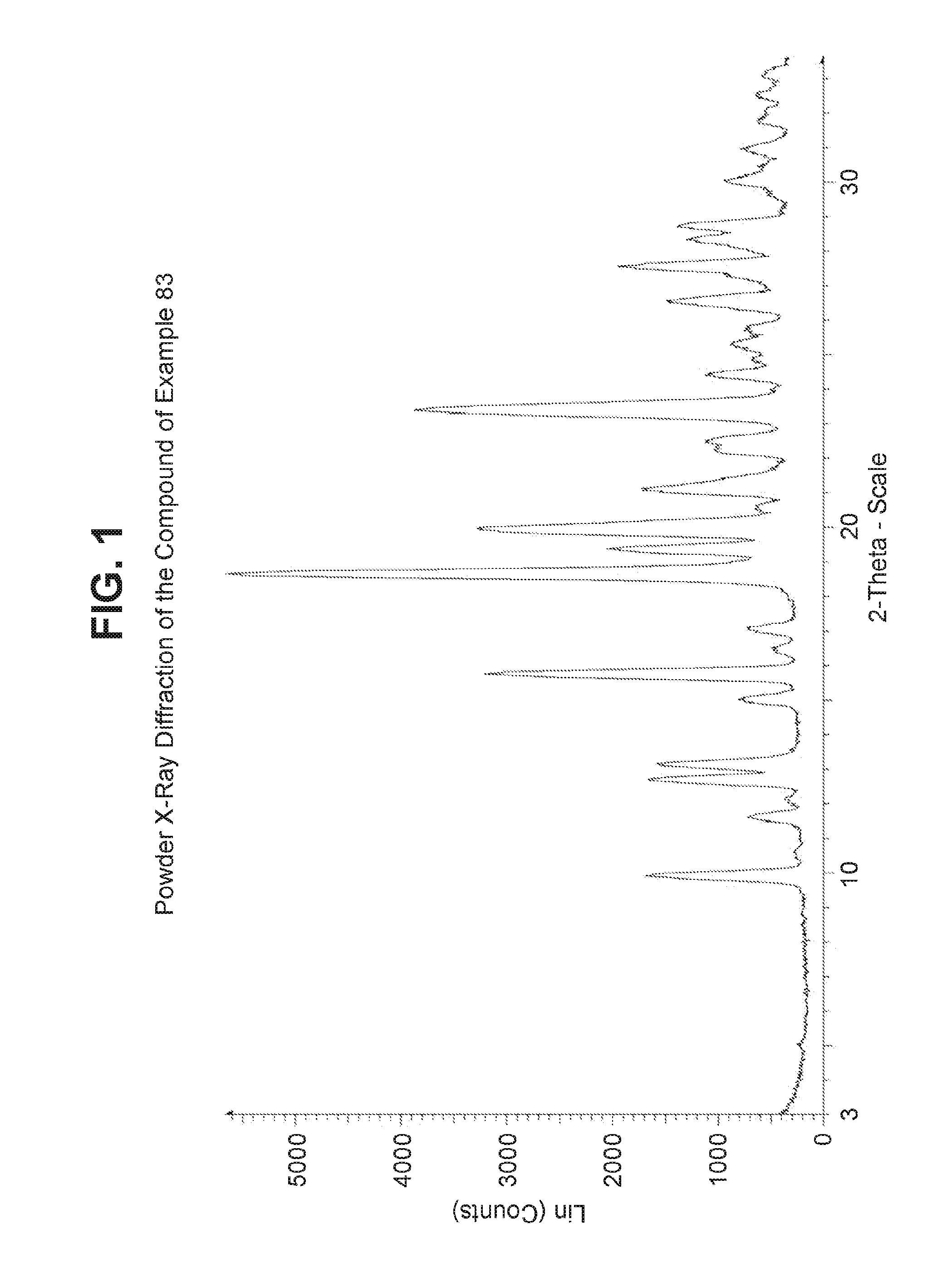Glucagon receptor modulators
- Summary
- Abstract
- Description
- Claims
- Application Information
AI Technical Summary
Benefits of technology
Problems solved by technology
Method used
Image
Examples
example 1
(+ / −)-3-(4-(1-(3-methyl-4-(4-(trifluoromethyl)-1H-imidazol-1-yl)phenylamino)butyl)benzamido)propanoic acid
[0387]
Step A: (+ / −)-methyl-4-(1-(3-methyl-4-(4-(trifluoromethyl)-1H-imidazol-1-yl)phenylamino)butyl)benzoate
[0388]
[0389]To a solution of Intermediate (21) (248 mg, 1.2 mmol) and Intermediate (4) (290 mg, 1.2 mmol) in methanol (12 mL) was added decaborane (44.1 mg, 0.36 mmol) at room temperature under nitrogen. The resulting solution was stirred at room temperature overnight. The reaction was concentrated and purification by column chromatography (0-35% ethyl acetate in heptane), gave (+ / −)-methyl-4-(1-(3-methyl-4-(4-(trifluoromethyl)-1H-imidazol-1-yl)phenylamino)butyl)benzoate as a foam. 1H NMR (500 MHz, CDCl3, δ): 8.02 (d, J=8.29 Hz, 2H), 7.48 (s, 1H), 7.42 (d, J=8.29 Hz, 2H), 7.25 (s, 1H), 6.90 (d, J=8.54 Hz, 1H), 6.41 (m, 1H), 6.34 (m, 1H), 4.40 (m, 2H), 3.91 (s, 3H), 1.98 (s, 3H), 1.72-1.87 (m, 2H), 1.34-1.52 (m, 2H), 0.96 (t, J=7.32 Hz 3H). MS (M+1): 432.4.
Step B: (+ / −)-ter...
example 2
(+ / −)-3-(4-(3-methyl-1-(4-(4-(trifluoromethyl)-1H-imidazol-1-yl)phenyl)butoxy)benzamido)propanoic acid
[0394]
Step A: (+ / −)-methyl 4-(3-methyl-1-(4-(4-(trifluoromethyl)-1H-imidazol-1-yl)phenyl)butoxy)benzoate
[0395]
[0396]Dimethylsulfoxide (1.5 mL) was added to a screw-top reaction vial charged with Intermediate (34) (128 mg, 0.339 mmol), 4-(trifluoromethyl)imidazole (55 mg, 0.406 mmol), copper (I) iodide (13 mg, 0.068 mmol), quinolin-8-ol (9.9 mg, 0.068 mmol), and potassium carbonate (92 mg, 0.67 mmol). The vial was evacuated and back-filled with nitrogen repeatedly then heated with stirring to 100° C. overnight. After 18 hours the reaction was diluted with saturated ammonium chloride (20 mL) and ethyl acetate (20 mL). The phases were separated and the organic layer was washed with water (2×20 mL) and brine (5 mL). The organics were dried over magnesium sulfate, filtered and concentrated. Purification by column chromatography (0-50% ethyl acetate in heptanes) gave (+ / −)-methyl 4-(3-met...
example 3
(+ / −)-3-(6-(1-(4-(4-(trifluoromethyl)-1H-pyrazol-1-yl)phenoxy)butyl)nicotinamido)propanoic acid
[0402]
Step A: (+ / −)-5-bromo-2-(1-(4-(4-(trifluoromethyl)-1H-pyrazol-1-yl)phenoxy)butyl)pyridine
[0403]
[0404]Intermediate (36) (216 mg, 0.50 mmol), 4-trifluoromethylpyrazole (68 mg, 0.50 mmol), copper (I) iodide (19 mg, 0.10 mmol), trans-4-hydroxy-L-proline (26.2 mg, 0.20 mmol) and cesium carbonate (329 mg, 1.00 mmol) were suspended in dimethylsulfoxide and heated to 85° C. with stirring for 18 hours. The reaction was diluted with ethyl acetate (25 mL) and washed with water (2×25 mL) and brine (20 mL). The organics were dried over magnesium sulfate, filtered and concentrated. Purification by column chromatography (0-50% ethyl acetate in heptanes) gave 5-bromo-2-(1-(4-(4-(trifluoromethyl)-1H-pyrazol-1-yl)phenoxy)butyl)pyridine (81 mg, 37%) as a clear oil. 1H NMR (400 MHz, CDCl3, δ): 8.63 (d, J=2.3 Hz, 1H), 8.00 (br. s, 1H), 7.82 (br. s, 1H), 7.75 (dd, J=8.4, 2.3 Hz, 1H), 7.49-7.43 (m, 2H), 7....
PUM
 Login to View More
Login to View More Abstract
Description
Claims
Application Information
 Login to View More
Login to View More - R&D
- Intellectual Property
- Life Sciences
- Materials
- Tech Scout
- Unparalleled Data Quality
- Higher Quality Content
- 60% Fewer Hallucinations
Browse by: Latest US Patents, China's latest patents, Technical Efficacy Thesaurus, Application Domain, Technology Topic, Popular Technical Reports.
© 2025 PatSnap. All rights reserved.Legal|Privacy policy|Modern Slavery Act Transparency Statement|Sitemap|About US| Contact US: help@patsnap.com



